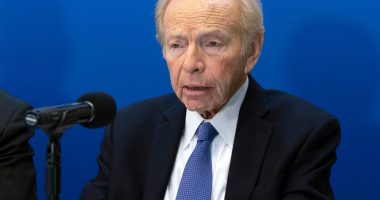Islamabad, Pakistan – Pakistan’s Prime Minister Shehbaz Sharif is scheduled to fly to China on June 4 for a five-day trip that will see him engage with Beijing’s top leadership, at a time when Islamabad has come to increasingly rely on its alliance with the world’s second-largest economy.
Sharif will visit Beijing, Xi’an and Shenzhen — the southern city that China showcases as a poster child of its dramatic economic rise since the 1980s. Shenzhen was handpicked by then-leader Deng Xiaoping as the country’s first special economic zone.
As Pakistan looks to similarly kick-start its economy from the doldrums, amid high inflation and a debt crisis, one multibillion-dollar economic project is at the heart of its ambitions:
The $62bn China-Pakistan Economic Corridor (CPEC), formally launched in 2015 by the two Asian nations, was pitted by the governments and many analysts in both countries as a “game-changer” for Pakistan’s economy. It included the construction of a flagship seaport, power plants and road networks across the South Asian country.
Yet nearly a decade later, questions hover over the future of the project.
The CPEC is a key component of China’s ambitious Belt and Road Initiative (BRI), a massive network of roads, bridges and ports spread across nearly 100 countries that Beijing hopes will recreate the ancient Silk Road trade routes linking Europe and Asia.
But critics say the BRI is a vehicle for China to expand its geopolitical influence and puts poorer countries such as Pakistan under more debt.
In Pakistan, the project included the building of a seaport at Gwadar in the south, along with the development of the country’s energy, transport and industrial sectors. While there were initial successes, the CPEC had a bumpy ride in Pakistan due to the country’s frequent political, economic and security crises and has effectively come to a halt.
Now, a recently-elected government in cash-strapped Pakistan is making a renewed push to ramp up the CPEC.
Why Pakistan needs CPEC
Nearly 40 percent of Pakistan’s 241 million people are below the poverty line, according to the World Bank. Inflation, which touched a devastating 40 percent a year ago, hovers around 20 percent now. An opinion poll before the national elections in February suggested that nearly 70 percent of Pakistanis believe their economic condition will continue to worsen.
In 2015, when Sharif’s elder brother and three-time Prime Minister Nawaz Sharif entered into the CPEC with China, Pakistan was facing a massive electricity crisis, hampering its industrial growth. Islamabad used the CPEC to develop a series of power projects, despite warnings of accumulating more debt.
Gwadar, the coastal city in the southwestern province of Balochistan, was picked to host the CPEC’s crown jewel: A deep sea port that could turn the city into a bustling economic hub. Meanwhile, a web of highways was announced across the country, aimed at providing connectivity from China’s southwestern city of Kashgar all the way down to Gwadar, more than 2,000km (1,242 miles) apart.
According to Ammar Malik, senior researcher at AidData, a research centre at the College of William and Mary in the United States, while the CPEC delivered some infrastructure and energy sector projects, it struggled to deliver more tangible benefits for Pakistan’s economy.
“CPEC has certainly improved sectors such as transportation or energy or provided enhancement in Pakistan’s capacity to produce electricity, but one has to translate these benefits into economic productivity and economic growth, which has not happened,” Malik told Al Jazeera.
The government’s data on the CPEC website itself corroborates that claim. The CPEC lists 95 projects, the largest being some $33bn planned as investments in the energy sector.
The data says out of 21 power projects, 14 have been completed so far with a combined capacity of 8500 megawatts, while two others are under construction and five are yet to start. Similarly, of the 24 proposed projects related to transport, only six have been completed and 13 are yet to see any work on them.
The CPEC, per the 2015 plan, was to include nine Special Economic Zones (SEZs) – designated areas with lenient trade laws to promote growth. But none have been completed so far, with work in progress on four of them.
The CPEC was estimated to generate more than two million employment opportunities for Pakistanis, but government data says less than 250,000 jobs have been created so far.
Meanwhile, Pakistan’s debt has continued to mount, putting a serious strain on its economy. When Nawaz Sharif came to power in 2013, Pakistan’s external debt stood at $59.8bn. Today, as his brother leads the nation, the same obligations have ballooned to $124bn — $30bn of which is owed to China.
The debt burden on Pakistan’s dwindling foreign reserves has paralysed a country heavily reliant on imports. Its central bank currently has $9bn, enough to cover for two months of import. The cash crisis has forced Islamabad to reach out to close allies, including China, to shore up its economy.
Pakistan is also negotiating with the International Monetary Fund (IMF) for another bailout package – its 24th since 1958.
But why is China wary?
The Chinese have repeatedly rolled over Pakistan’s loan repayment deadlines, including about $2bn due earlier this year. But China has its own concerns.
Only this year, five Chinese nationals working on various CPEC projects have been killed in attacks by armed groups, who have openly admitted to targeting Chinese interests in Pakistan.
Dozens of Chinese workers have been killed across Pakistan since 2018, mainly in Balochistan where an armed rebellion against the Pakistani state has been going on for several years. The Baloch rebels now blame the Chinese projects in the province as a theft of their resources.

Stella Hong, a China public policy postdoctoral fellow at the Harvard Kennedy School’s Ash Center, told Al Jazeera that Pakistan’s security situation “remains the most immediate concern” for the Chinese and may impact their future investments in the country.
“The violent incidents are also putting the two governments’ mutual trust to the test. There might be growing reservation from both the countries about the other side’s commitment to this relationship,” she said.
Khalid Mansoor, who headed the government’s CPEC Authority for nearly nine months before being replaced in April 2022, said the primary demand of the Chinese is foolproof security.
“But despite the recent attacks, I can say this with confidence that the Chinese remain committed to the [CPEC] project,” he told Al Jazeera.
Weak governance
According to AidData’s Malik, the other major concern for the Chinese is governance – or the lack of it.
“In any good partnership, there are two partners and I have over the years heard the Chinese complain about not being facilitated to carry out their work. The support they seek has not been given to them,” he told Al Jazeera.
Hong agreed, saying Pakistan needs to do more if it expects the Chinese companies to relocate and expand operations in the country.
“Companies need to be able to run viable businesses if they were to relocate to Pakistani SEZs or even in Pakistan in general. But many seem to have been frustrated by the difficulties of getting things done in Pakistan,” she said.
But economist Safdar Sohail, who was part of the government panel that supervised the implementation of the CPEC project when it was launched, hoped the creation of a Special Investment Facilitation Council (SIFC) could help resolve the governance issue.
Shehbaz Sharif formed the SIFC in his previous tenure as prime minister last year. The government body, represented by top civilian and military officials, is meant to serve as the top decision-making forum to ensure the execution of economic policies.
Safdar believed the SIFC may also remove the bureaucratic issues that have affected the pace of the CPEC projects in Pakistan.
“But I think to really avail the potential of CPEC, we need to have a forward-looking plan instead of short-term projects that may only add to our debt burden,” he told Al Jazeera.
Read More: World News | Entertainment News | Celeb News
Aljazera








